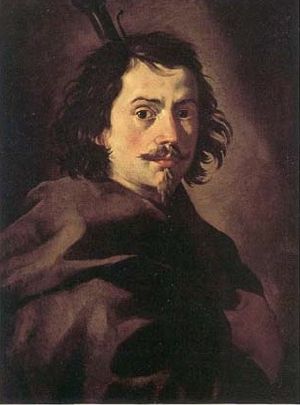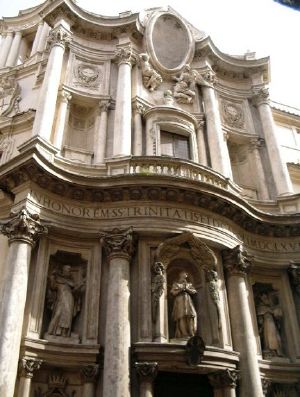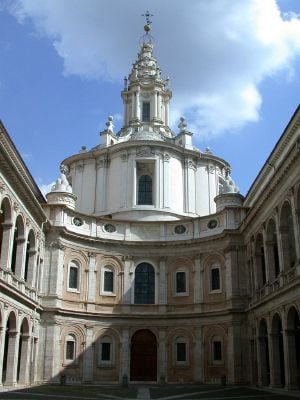Francesco Borromini
Francesco Borromini, also Francesco Castelli (September 25, 1599 – August 3, 1667) was a prominent and revolutionary Neapolitan and Sicilian Baroque architect in Rome. His major works included the baldachin of St. Peter’s Basilica, the reconstruction of San Carlino, expansion of Sant’Agnes, the design of Sant' Ivo alla Sapienza, and the oratory of Saint Phillip Neri. Borromini was originally inspired by such architects and sculptors as Carlo Maderno and Gian Lorenzo Bernini, but Borromini’s first independent design, San Carlino, displays a style unique to Borromini himself. Borromini’s works often include bold, geometric designs, such as the six-pointed star-shaped floor of the Sant’ Ivo all Sapienza.
Borromini killed himself in 1667, and three centuries later he was featured on the one hundred Swiss Franc banknote.
Early Life and First Works
Francesco Borromini was born to Giovanni Domenico Castelli and Anastasia Garovo. Following his father’s footsteps, Borromini moved to Milan to study and practice stone masonry. In 1919 Borromini moved to Rome and changed his name from Castelli to Borromini. He soon began working for a distant relative named Carlo Maderno at St. Peter's. After Maderno’s death in 1629, Borromini began working closely with famous painter and sculptor Gian Lorenzo Bernini. Together they would successfully complete the facade and expansions of Maderno's Palazzo Barberini and build the enormous bronze baldachin at St. Peter’s Basilica.
San Carlino (San Carlo alle Quattro Fontane)
Borromini's first major independent commission was the reconstruction of the interior spaces of the church and adjacent buildings of San Carlo alle Quattro Fontane (also called San Carlino) (1634-37). San Carlino was dedicated to San Carlo Borromeo, and today is considered an iconic masterpiece of Roman Baroque architecture. In designing the church, Borromini avoided linear classicism and eschewed a simple circular shape in favor of a corrugated oval. Siegfried Giedion pointed out in Space, Time and Architecture (1941 etc.), that Borromini "designed the walls to weave in and out as if they were formed not of stone but of pliant substance set in motion by an energetic space, carrying with them the deep entablatures, the cornices, moldings and pediments" (Trachtenberg & Hyman). Compared to Bernini’s Sant'Andrea al Quirinale, which lies just down the street, San Carlino is far bolder in geometric intricacy and less encrusted with figurative decorationsCite error: Closing </ref> missing for <ref> tag The flexing boldness of Borromini’s San Carlino bore fruit in the distinctive Neapolitan and Sicilian Baroque.
Sant'Agnese in Agone
Another notable piece of architecture designed by Borromini was the Sant’Agnese in Agone, Rome. For Sant'Agnese in Agone, Borromini reverted the original plans of Girolamo Rainaldi (and his son Carlo Rainaldi), which previously had its main entrance on Via di Santa Maria dell'Anima, and expanded the façade to include parts of the bordering Palazzo Pamphilj. By doing so, Borromini was able to obtain space for the two bell towers (each of which has a clock, one for Roman time and the other for European time). Before completing Sant’Agnese, Borromini lost his commission due to the death of the Pope Innocent X(1655). The new Pope, Alexander VII, and Prince Camillo Pamphili, then recalled Italian architect Girolamo Rainaldi to complete the project, although the Sant’Agnese would predominately display Borromini's concepts.
Sant' Ivo alla Sapienza
From 1640-1650, Borromini worked on the design of the church of Sant'Ivo alla Sapienza. Built at the end of Giacomo della Porta's long courtyard, the Sant’ Ivo alla Sapienza’s dome and cochlear steeple are peculiar, and reflect the idiosyncratic architectural motifs that distinguish Borromini from other contemporaries. Inside, the nave has an unusual centralized plan. It is circled by alternating concave and convex-ending cornices, and leads to a dome decorated with linear arrays of stars and putti. The church’s floor is a symmetric, six-pointed star. From the center of the floor, the cornice looks like two equilateral triangles forming a hexagon; three of the points are clover-like, while the other three are concavely clipped. Collectively, the innermost columns of the Sant’ Ivo alla Sapienza form points on a circle. The varying architectural features of the Sant’ Ivo alla Sapienza fuse together feverish and dynamic baroque excesses with rationalistic geometric styles.
Oratory of Saint Phillip Neri (Oratorio dei Fillipini)
After winning a contest against such renowned architects as Paolo Maruscelli, Borromini was employed to design the oratory and library of the church of Saint Phillip Neri, located in the center of Rome. Although the congregation of Saint Phillip Neri already had one of the most well-decorated Baroque churches in Rome, they planned to build an oratory, as well as residential quarters, adjacent to the church of Santa Maria in Vallicella (Chiesa Nuova). Borromini worked on his design for thirteen years, and by 1640, the oratory was in use. Three years later, the library was complete. The oratory of Saint Philllip Neri was characterized by a striking facade adjacent to the church entrance, articulate half columns, and a complex rhythm of pilasters.
Borromini was a contemporary with the prolific papal architect, and, late in life, a rival of, the eminently successful Gian Lorenzo Bernini. Borromini is purported to have been a strong influence on the Piedmontese architect, Camillo-Guarino Guarini and his successors.
Other works
Borromini's works include:
- Interior of Basilica di San Giovanni in Laterano
- Cappella Spada, San Girolamo della Carità (uncertain attribution)
- Palazzo Spada (trick perspective)
- Palazzo Barberini (upper-level windows and oval staircase)
- Santi Apostoli in Naples - Filamarino Altar
- Sant'Andrea delle Fratte
- Oratorio dei Filippini
- Collegio de Propaganda Fide [2]
- Santa Maria dei Sette Dolori
- San Giovanni in Oleo (restoration)
- Palazzo Giustiniani (with Carlo Fontana)
- Facade of Palazzo Falconieri
- Santa Lucia in Selci (restoration)
- Saint Peter's Basilica (gates to Blessed Sacrament Chapel and possibly parts of baldacchino)
Death and Epitaph
In the summer of 1667, Borromini, suffering from nervous disorders and depression, committed suicide in Rome. His death directly followed the completion of the Falconieri chapel (the main chapel) in San Giovanni dei Fiorentini, where he was buried (account).
The inscription of Borromini's tomb in San Giovanni dei Fiorentini reads:
FRANCISCVS BORROMINI TICINENSIS
EQVES CHRISTI
QVI
IMPERITVRAE MEMORIAE ARCHITECTVS
DIVINAM ARTIS SVAE VIM
AD ROMAM MAGNIFICIS AEDIFICIIS EXORNANDAM VERTIT
IN QVIBUS
ORATORIVM PHILLIPINVM S. IVO S. AGNES IN AGONE
INSTAVRATA LATERANENSIS ARCHIBASILICA
S. ANDREAS DELLE FRATTE NVNCVPATUM
S. CAROLVS IN QVIRINALI
AEDES DE PROPADANDA FIDE
HOC AVTEM IPSVM TEMPLVM
ARA MAXIMA DECORAVIT
NON LONGE AB HOC LAPIDE
PROPE MORTALES CAROLI MADERNI EXUVVIAS
PROPINQVI MVNICIPIS ET AEMVLI SVI
IN PACE DOMINI QVIESCIT
Francesco Borromini was featured on the one hundred Swiss Franc banknote current in the 1980s [1].
Notes
External links
- Columbia University: Joseph Connors, Francesco Borromini: Opus Architectonicum, Milan, 1998: Introduction to Borromini's own description of the Casa dei Filippini
- Borromini's own account of his eventually successful suicideattempt
- (3)Marvin Trachtenberg and Isabelle Hyman. Architecture: from Prehistory to Post-Modernism, p346-7.
Credits
New World Encyclopedia writers and editors rewrote and completed the Wikipedia article in accordance with New World Encyclopedia standards. This article abides by terms of the Creative Commons CC-by-sa 3.0 License (CC-by-sa), which may be used and disseminated with proper attribution. Credit is due under the terms of this license that can reference both the New World Encyclopedia contributors and the selfless volunteer contributors of the Wikimedia Foundation. To cite this article click here for a list of acceptable citing formats.The history of earlier contributions by wikipedians is accessible to researchers here:
The history of this article since it was imported to New World Encyclopedia:
Note: Some restrictions may apply to use of individual images which are separately licensed.



